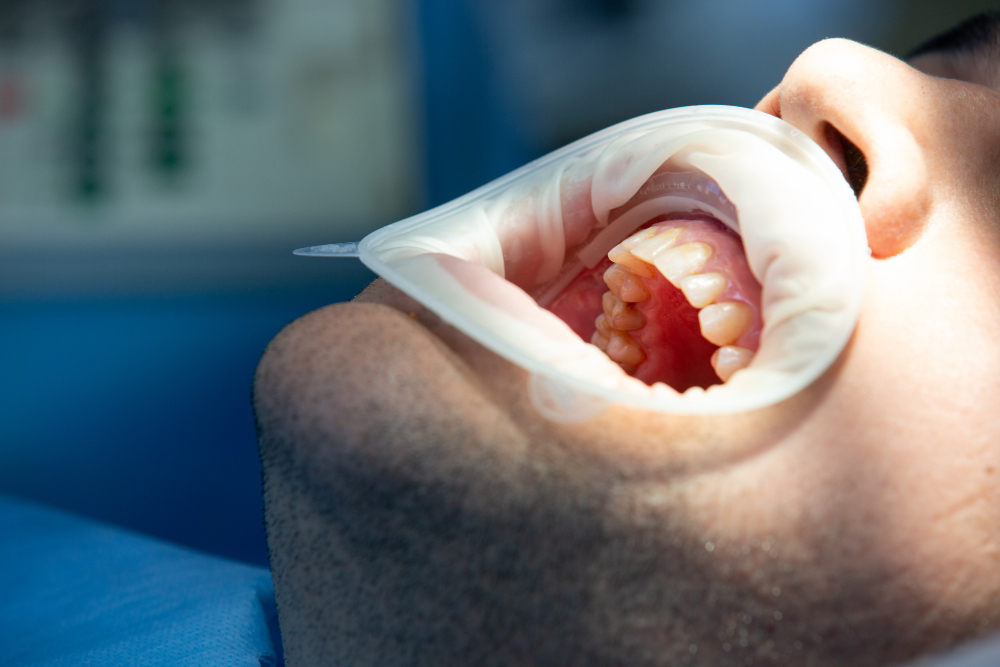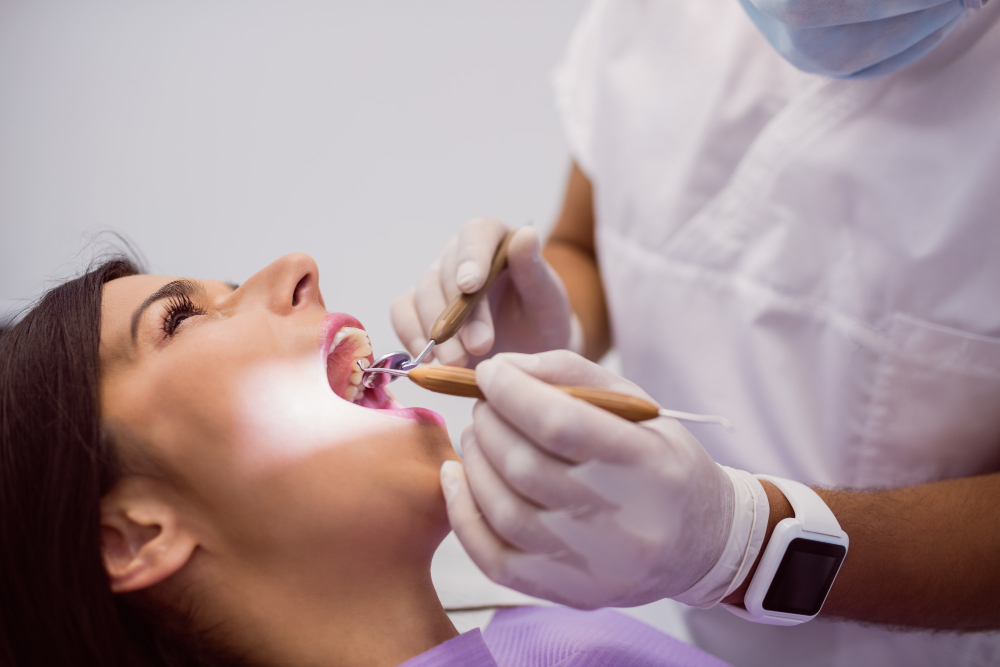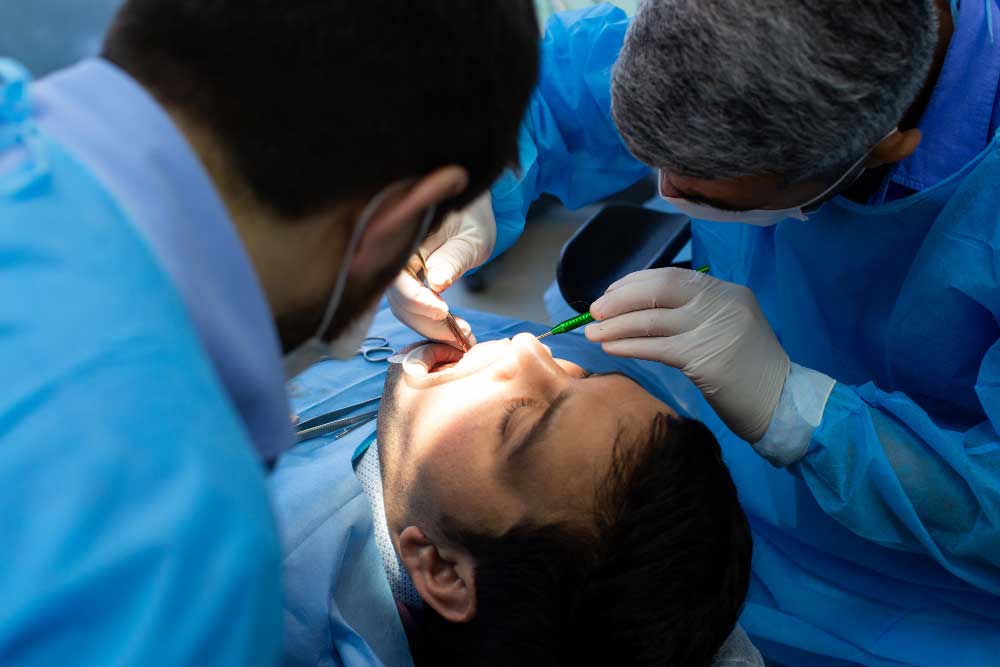Table of Contents
ToggleTooth extraction usually settles without fuss, yet a small number of patients develop “dry socket”, the lay term for alveolar osteitis. The condition feels far worse than the name suggests: raw bone is exposed, the clot that should protect the site has vanished, and nerves complain loudly. While it rarely threatens general health, the pain can overshadow daily tasks and delay recovery.
Why dry socket happens
During an extraction, a blood clot forms to seal the socket and start tissue repair. If that clot dissolves too soon, is rinsed away, or never forms properly, the underlying bone sits unprotected. Bacteria and air irritate the site, triggering inflammation and the aching that often radiates toward the ear or temple. Studies place overall incidence at roughly 2–5 per cent, climbing into the mid-teens for difficult lower third-molar procedures.
Who is more likely to be affected?
Research points to several overlapping factors that raise the odds:
- Smoking introduces chemicals that slow healing and the suction motion can dislodge the clot. Smokers face more than three times the risk of non-smokers.
- Oral contraceptives raise oestrogen levels, known to interfere with normal clot stabilisation.
- Traumatic or lengthy surgery increases tissue damage and bacterial load.
- Poor oral hygiene or pre-existing infection around the tooth.
- Age over forty and a history of previous dry socket also feature in recent Australian audits.
So, if you were searching online for Wisdom teeth removal Sydney, it helps to be aware of these variables before booking.

Timeframe and warning signs
Normal post-extraction discomfort eases within two days. Dry socket pain, by contrast, often intensifies on day three or day four and is described as throbbing or drilling in nature. Look for:
- A visible gap where a clot should sit – white bone may be seen.
- Foul taste or odour.
- Pain that radiates to the ear, eye, or neck on the same side.
- Mild fever or lymph-node tenderness in a minority of cases.
These features call for prompt contact with your dental team; over-the-counter tablets rarely quieten an exposed socket for long.
First-aid measures at home
Waiting a day for your review appointment can feel eternal, yet a few steps minimise discomfort:
- Warm salt-water rinses – a quarter teaspoon of salt in a cup of lukewarm water – flush debris without disturbing tissue.
- Non-prescription anti-inflammatories such as ibuprofen tame the ache; follow the packet.
- Avoid smoking, vaping, or alcohol as they hinder clot reforming.
- Soft foods like yoghurt, mashed vegetables, or scrambled eggs reduce mechanical stress.
- A pharmacist can advise on clove-oil gels that give temporary relief.
If you have been comparing the Wisdom teeth removal cost Sydney clinics advertise, remember that prolonging dry socket through smoking or strenuous exercise may add to your expenses.
What your dentist will do
At review the clinician irrigates the socket, places a medicated dressing (often eugenol-based), and may issue stronger analgesics or antibiotics. Pain usually drops within hours, though some dressings need replacement every second day until granulation starts.
Prevention tips for future extractions
- Skip straws for a week.
- Bite on gauze for the period advised after surgery.
- Brush twice daily but steer clear of the extraction zone on day one, then resume gentle cleaning.
- Ask whether a pre-op chlorhexidine rinse is recommended; research suggests it can halve dry socket rates.
Prospective patients weighing the cost of wisdom teeth removal Sydney dentists quote often ask whether preventive steps cost extra. In most practices they are part of standard care.

Keeping costs and expectations realistic
A complicated lower wisdom tooth can involve specialist fees, 3D imaging, or hospital day-surgery charges. If you see a headline such as Wisdom Teeth Sydney promising bargain rates, verify what is included: sedation, pathology, follow-up visits, and management of complications like dry socket.
The same logic applies when a clinic advertises Wisdom teeth removal price Sydney specials. Ask how many sockets their figure covers, which medications are supplied, and whether after-hours advice is available.
The myth of a quick fix
Internet tips such as rinsing with spirits, scraping the socket, or packing it with household clove paste risk infection and rarely deliver lasting relief. Only professional debridement and dressing create the conditions for healthy tissue to return.
Planning your post-op week
Arrange lighter duties, stock the freezer with soft meals, and line up entertainment that does not involve vigorous exercise. Should symptoms surge despite good care, note that after-hours clinics can place an interim dressing. Delays simply extend the pain window.
When will it all settle?
Once medicated dressings after cheap wisdom teeth removal Sydney are in place most sockets stop aching within two to three days. Full mucosal coverage usually follows in seven to ten days, and bone fills over the next few weeks. Keep your follow-up schedule: even minor discomfort can be reviewed quickly, preventing a small problem from turning into a second round of dry socket. For students and families seeking affordable wisdom teeth removal Sydney solutions, choosing a practice that emphasises clear home-care instructions and ready support is the smartest economy of all.
Frequently Asked Questions
1. Why does dry socket hurt more than extraction pain?
The clot disappears or never forms, leaving bone bare. Bone irritates nerves, so ache spikes three days after surgery, radiating to the ear and giving foul taste. Typical healing feels sore yet eases daily because the clot remains intact.
2. Can dry socket be avoided, and which steps matter most?
Avoid risk by not smoking, using chlorhexidine rinse, biting on gauze firmly, and skipping straws or rinses for a week. Clean the site with salt baths after meals. These habits protect the clot and encourage faster, comfortable healing.
3. What can I do at home if I suspect dry socket while waiting for review?
Take ibuprofen, apply cold packs, rinse with salt water. Skip smoking, alcohol, strenuous exercise. Choose soft meals. Clove gel may ease pain briefly but cannot substitute for cleaning and dressing by your dentist.
4. Will antibiotics alone fix dry socket?
No. Dry socket pain stems from lost clot and exposed bone, not primary infection. Antibiotics help only if infection is present. Relief comes from irrigation and dressings that shield bone while new tissue forms. Continue antibiotics when prescribed, but expect dressing treatment.
5. How long does dry socket last, and when will I feel normal again?
Dressings usually reduce pain within hours, with steady relief over three days. Gum closes in about ten days. Bone repairs for weeks, but full normal comfort and chewing generally resume two weeks after the extraction.
6. Does having wisdom teeth removed under sedation alter dry socket risk?
Sedation itself neither raises nor lowers risk. Surgical difficulty, smoking, and home care drive outcomes. Sedated patients may forget instructions; arrange written directions and help at home to manage salt rinses, gentle brushing, medicines, and rest, safeguarding the clot.




